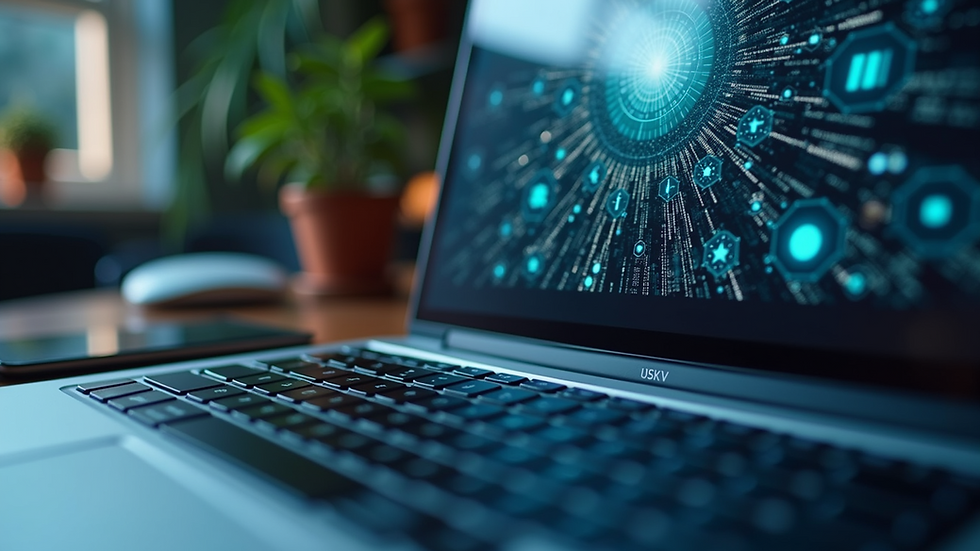How Generative AI is Changing the Workflow but not the People Behind It
- sagar2309
- Mar 28
- 4 min read
Generative AI has emerged as a transformative tool in various industries, revolutionizing workflows while allowing human creativity and critical thinking to remain at the forefront. This technology generates text, images, and other content, helping streamline processes that traditionally relied heavily on human input. In this article, we will explore how generative AI is enhancing workflows, providing real-world examples, and discussing what this means for the people who use it.
The Rise of Generative AI in Workflows
Generative AI has gained significant traction in recent years. According to a report from McKinsey, nearly 70% of companies are experimenting with AI technologies, including generative AI, to improve efficiency. This growing trend reflects the belief that AI can augment human capabilities rather than replace them.

By leveraging machine learning, generative AI can create content based on the data it has been trained on. This capability allows businesses to automate repetitive tasks, freeing employees to focus on higher-value projects. For instance, AI can draft basic emails or generate reports based on specific inputs.
How Generative AI Facilitates Collaboration
One of the most significant benefits of generative AI is its ability to enhance collaboration among teams. AI tools can analyze input from various team members and produce cohesive outputs, making it easier for groups to work together, regardless of their location.
For example, platforms like OpenAI's ChatGPT can assist in brainstorming sessions by providing relevant information or generating ideas based on user prompts. This not only speeds up the idea generation process but also ensures that every team member has access to the same information.

As teams increasingly adopt generative AI tools, they report improved productivity and creativity. A survey by PwC found that organizations employing AI-driven tools experienced a productivity increase of approximately 40%. With generative AI facilitating collaborative efforts, employees can focus more on crafting innovative strategies rather than getting bogged down in mundane tasks.
Managing Data More Effectively
In addition to enhancing collaboration, generative AI allows organizations to manage data more effectively. By analyzing large datasets quickly, AI tools can produce insights that would take humans much longer to generate.
For example, generative AI can be used to identify trends in customer behavior, enabling companies to tailor their marketing strategies accordingly. According to a study by the International Data Corporation (IDC), businesses that utilize AI-driven analytics can achieve a 30% increase in revenue from improved customer engagement.

This shift means that employees can make data-driven decisions faster, potentially leading to better outcomes. By automating the analysis process, generative AI allows individuals to focus on strategy and implementation instead of being immersed in raw data.
The Human Element: Skills that Matter
Despite the numerous advantages offered by generative AI, it is crucial to note that the human element remains vital in the workplace. AI cannot replicate human intuition, emotional intelligence, or creativity. These qualities are essential for creating meaningful connections with clients and developing innovative solutions.
Companies should focus on upskilling their workforce to complement AI technologies. Investing in training programs that enhance skills such as critical thinking, problem-solving, and digital literacy will ensure that employees can effectively collaborate with AI systems.
Surveys indicate that businesses prioritizing continuous learning are more likely to thrive in an AI-driven landscape. For example, a LinkedIn report shows that 94% of employees would stay longer at a company that invests in their career development.
The Future of Work with Generative AI
As generative AI continues to evolve, the future of work promises to be increasingly integrated with technology. As a result, employees will find themselves working alongside AI systems, using them as tools to enhance their productivity and creativity rather than as replacements.
Organizations must prepare for these changes by fostering a culture of innovation and flexibility. This includes adopting a mindset that embraces AI as a collaborator rather than a competitor. By doing so, companies can navigate the complexities of the modern workforce while ensuring that their employees remain engaged and motivated.
Incorporating generative AI also requires thoughtful implementation. Leaders should consider the ethical implications and potential biases that might emerge from AI-generated content. Awareness of these factors is essential in maintaining trust among stakeholders and ensuring that the technology is used responsibly.
Embracing Change and Staying Relevant
In conclusion, generative AI is undoubtedly changing the way we work. It streamlines processes, enhances collaboration, and provides valuable data insights. However, the human element cannot be overlooked. The individuals behind these technologies and workflows are what truly drive innovation and progress.
As businesses continue to adopt generative AI, they should prioritize the development of their workforce, ensuring that employees possess the skills needed to thrive in an evolving landscape. Embracing change and remaining adaptable will empower organizations to leverage generative AI effectively while maintaining the essential human touch.
In summary, the integration of generative AI into various workflows represents an opportunity for employees to work smarter, not harder. The future appears bright for those willing to embrace this technology, with the right balance of human creativity and AI capabilities leading the way toward unprecedented productivity and innovation.








Comments